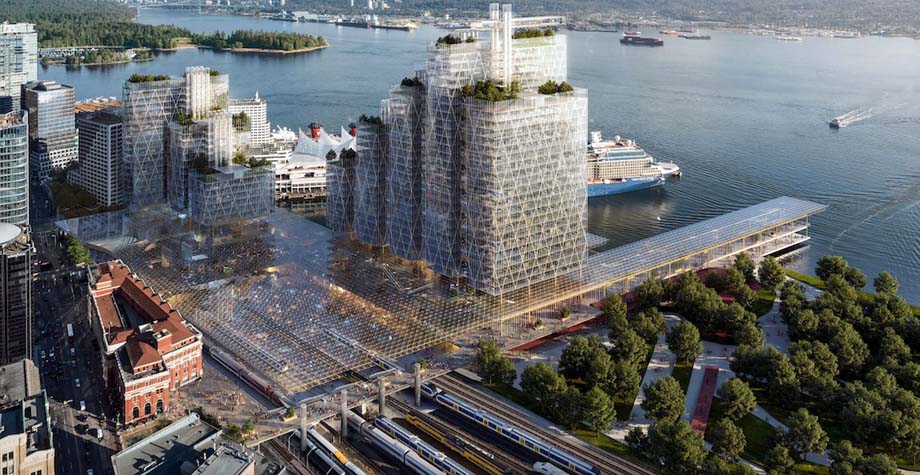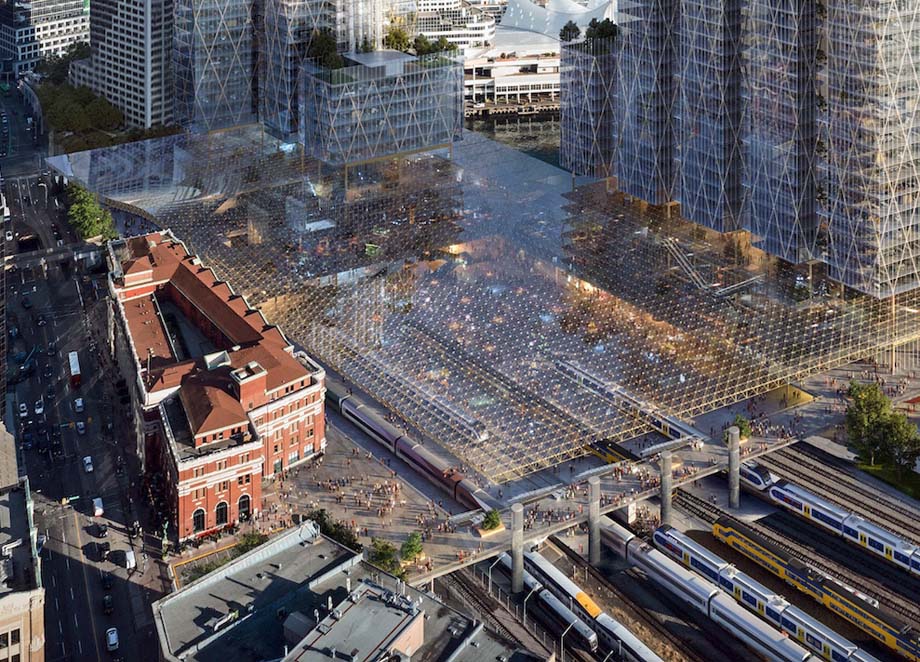
Vancouver British Columbia - What would a world-class, multi-modal, public transit hub, fully
integrated with a high-density mix of commercial uses look like at Waterfront Station in downtown
Vancouver?
This question has long been posed by the City of Vancouver, which first established the Central Waterfront Hub
Framework in 2009 to expand Waterfront Station with a transit concourse over the rail yard to the north side of the
historic building, along with opening up the ability for significant office and hotel developments and new public
spaces.
But over the decade that has passed, no real action to implement the Waterfront Station plan has been made, which
triggered the April 2022 decision by the previous makeup of Vancouver City Council directing City of Vancouver staff to
restart the planning process for the transit hub and precinct towards implementation.
This also includes collaborating with the federal and provincial governments, TransLink, Port of Vancouver, Pavco
(Vancouver Convention Centre), and Canadian Pacific.
Half a year later, a new concept for this very idea of transforming and expanding Waterfront Station has
emerged.

The Vancouver office of global architectural firm Perkins & Will shared its concept with Daily Hive of the
potential of Waterfront Station's future, a transit hub that is "Vancouver's answer" to some of the largest
train stations in major Asian and European cities.
It goes far beyond what the municipal government's 2009 concept had envisioned, but it retains the key principles of
retaining and integrating the historic 1914-built Canadian Pacific Railway station now associated as Waterfront
Station, a new transit concourse, increasing amenities, and capacity for public transit, setting aside space for new
rail lines, opening up public access to this portion of the waterfront east of Canada Place, and high-density
commercial development.
It should be strongly emphasized that Perkins & Will's concept is not an actual proposal, its design was created as
a case study to ignite public interest and discourse on the forthcoming discussions on the future of Waterfront
Station.
Such a concept would certainly carry a multi-billion dollar construction cost.
Artistic renderings by Perkins & Will's architects show a transit concourse with a landmark glass-covered canopy
spanning a large deck built over the existing rail yard, exponentially larger in scale than the City's 2009
concept.
The station is envisioned as a covered outdoor space, and its expansive roof could serve the dual purpose of renewable
energy generation, such as through the installation of solar panels.
"Our proposition for Waterfront Station will be user-centric with a high level of service. The creation of
generous, open, day-lit concourses, characterized by spatial continuity, will facilitate legible orientation and
intuitive way-finding. The precinct will become a destination, providing a wide range of functions beyond those
associated specifically with transit, a vital aspect of city life, reflecting its central location within the downtown
core," reads the vision.

To achieve the most optimal footprint for the project, there would be some construction over water with pilings,
and two existing office towers, the 2002 built, 20 storey PricewaterhouseCoopers tower and the 1972 built, 33 storey
Granville Square tower, would be demolished.
As well, Cadillac Fairview's proposed 26 store office tower on the east side of the CP building, replacing an existing
surface parking lot, would not go ahead.
"Incremental aggregation of development, in the absence of a structured masterplan, has resulted in co-location
rather than integration with respect to transit services. A confused attitude to the broader urban context has resulted
in ambiguity rather than coherence, which has also negatively impacted the heritage value and cultural potential of the
site. A critical aspect of our study is the transformation of Waterfront Station into a symbolically appropriate
gateway. We believe this site should become synonymous with a positive image of the city," continues the
vision.
Instead of abruptly ending at the entrance of a parkade below Granville Square, Granville Street would see a
pedestrian-only extension northwards, reaching the water's edge and connecting with an extension eastward of Canada
Place Way for pedestrians and cyclists.
Beneath the deck, platform space would be set aside for an expansion of the existing West Coast Express commuter rail
service, plus dedicated platforms for the terminus of the high-speed rail service linking Vancouver to Seattle and
Portland, including the required supporting baggage handling and logistics spaces.
Access to SkyTrain's Canada Line and Expo Line would be enhanced, and the SeaBus terminal would be shifted into a new
marine terminal facility, which could also accommodate a new BC Ferries route to Nanaimo using passenger-only
vessels.
The existing heliport serving Waterfront Station would be relocated to the rooftop of a new office tower on the
site.
"As part of a simplified system, we envision the integration of SkyTrain lines into a single nodal
interchange. Our schematic vision safeguards a potential high-speed rail connection within a terminus providing both
intracity and inter-provincial rail services, with grade connections to mass transit, marine services, a new Skyport,
and personal and autonomous mobility services," states the vision.
The length of the site's edge with the waterfront would be publicly accessible over multiple levels, including the
construction of a multi-level pier and public space on the eastern edge of the site, also covered by the same seamless
glass-covered canopy that extends across the station.
In addition to the transit hub and public spaces, there would also be significant new towers for office and hotel uses,
fully integrated with the precinct.
The City's 2009 concept conservatively set aside over 1.4 million square feet of space for offices, hotels,
restaurants, dining, and other service-based uses.
Perkins & Wills' concept also calls for a 500,000 square feet civic/cultural hub situated below the western cluster
of new office and hotel towers that replace the footprint of the PricewaterhouseCoopers and Granville Square
towers.
They envision this hub could be used for the Canadian Centre for the Moving Image, Vancouver Arts Theatre, and the
Central City visitor centre.
To the east of the precinct, their concept envisions a pick-up and drop-off hub for autonomous vehicles, accessible by
Waterfront Road, as well as a westward expansion of Crab Park on vacant Port-owned lands and a new north-south
pedestrian bridge over the rail yard between the park and the foot of Cambie Street to reach Gastown.
Within Metro Vancouver, Perkins & Will is known for some of the region's most successful transit-oriented
developments, including Marine Gateway, Crossroads (Broadway and Cambie), the Safeway redevelopment proposal next to
SkyTrain Expo Line's Commercial-Broadway Station, and the immense 800 Granville block redevelopment
proposal.
It is also behind the designs of SkyTrain Canada Line's three stations along No. 3 Road within Richmond, and the
architecturally unique design of SkyTrain Millennium Line's Brentwood Town Centre Station.
Over the decades, there have been several ideas for repurposing the air space north of Waterfront Station, including
the 1990s proposal for a major hotel and convention centre complex by Steve Wynn, who is best known for his
mega-casinos in Las Vegas.
After Wynn's proposal fell apart, this site east of Canada Place was still the presumed location of the first expansion
of the Vancouver Convention Centre, until the provincial government made the decision in the early 2000s to build the
expansion on Burrard Landing on the west side of Canada Place.
More than a decade after Vancouver Convention Centre's West Building's opening in time for its use as the International
Broadcast Centre for the 2010 Winter Olympics, it is increasingly apparent the incorporation of a convention centre
expansion as one of the uses of the Waterfront Station precinct would be the final opportunity to allow for a seamless
expansion of the convention centre, and secure its long-term competitiveness and purpose as an economic and tourism
engine.
The City's 2009 plan was not implemented due, in part, to the high cost of the concept's construction of road viaduct
extensions of Canada Place Way and Granville Street to serve the tower developments and transit hub, the Port's
interest in preserving its waterfront property for future port-related operations, and the City's attention to other
projects, especially the Northeast False Creek Plan to demolish the Dunsmuir and Georgia viaducts.
The 2009 plan was triggered by the proposal by the Vancouver Whitecaps FC to build an outdoor stadium, with a capacity
of 15,000 seats, expandable to 30,000 seats, over the rail yard north of Gastown.
Although the stadium would have been fully privately funded by the franchise, the municipal government did not approve
it due to technical challenges relating to the site and safety over the rail yard.
Kenneth Chan.
 Article abridged - several photos and drawings removed.
Article abridged - several photos and drawings removed.
(likely no image with original article)
(usually because it's been seen before)
provisions in Section 29 of the
Canadian Copyright Modernization Act.

